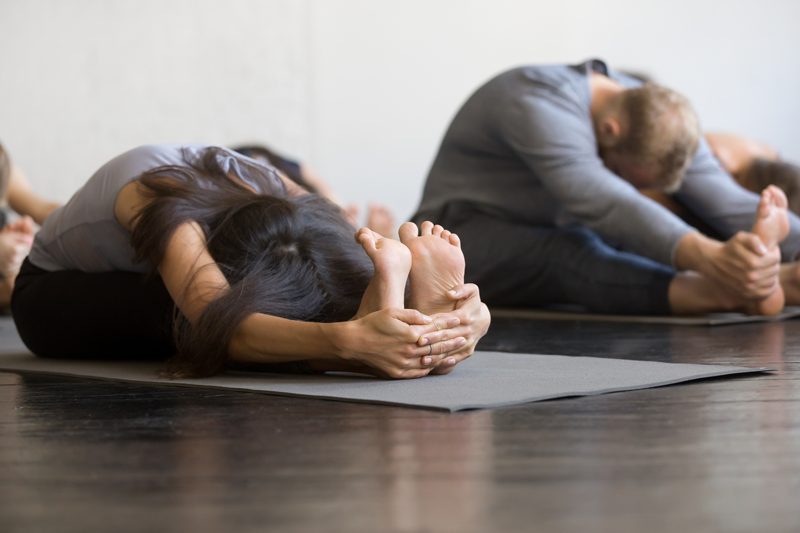
The Top 5 Mindfulness Destinations Around the World
12th July 2019
Yoga for Neck and Shoulder Pain
19th July 2019The Science Behind Yin Yoga

Yin Yoga is a slow-paced yoga style that focusses on physical asanas. In Yin Yoga, the postures are held for a longer duration than they are in other styles. Beginners are advised to hold each pose for around two minutes, while more experienced yogis are encouraged to hold each stretch for five minutes. At the end of each pose, practitioners are advised to rest on the yoga mat for a few seconds before moving onto the next stretch. But why are the postures held for an extended duration? In this article, we explore the science behind Yin Yoga.
The Science Behind It
Holding each pose for at least two minutes helps the mind and body to relax. However, there is more to it than that. The human body is made up of yin and yang tissues. As muscles fall into the yang category, yang activity is needed to strengthen them. Yang activity is best described as repetitive movements to create heat. Shorter holds, quick movement, and dynamic stretching all target the yang tissues.
Longer, static holds are used to access yin tissue, including fascia and connective tissue. To keep the joints healthy, we need a balanced combination of both yin and yang. Teeth are a great example of a yin part of the body. In order to change the position of teeth, gentle pressure over a long period of time is required, rather than knocking or hammering away at them quickly. This is the same for our fascia and connective tissue. Fascia is a continuous web of tissue that surrounds our muscles, organs, nerves, and lymph. It’s often compared to a pair of tights used inside the body to keep everything in place. When you pull a piece of meat apart, you can sometimes see white, glistening fibres – that is fascia. To keep it healthy, strong, and flexible, we need to apply gentle pressure with longer holds.
Originally, Yin Yoga was used by meditation students who found it difficult to sit on the floor for long periods of time. The gentle stretching of the practice helps to open tight hips and hamstrings, making it easier to sit cross-legged without pain. The longer hold allows students to move deeper into the stretch and get the most benefit from the practice.
How is Yin Yoga Different from Yang Yoga?
There are two key principles that separate Yin Yoga from Yang Yoga. These are holding the poses for several minutes and stretching the connective tissue around a joint. To achieve the latter, the muscles must first be relaxed. If the muscles are tight, the connective tissue won’t receive the proper stretch. You can demonstrate this by pulling gently on your middle finger, first with your hand tensed and then with it relaxed. When the hand is relaxed, you’ll feel a stretch in the joint where the finger meets the palm. This sensation is the connective tissue stretching. When the hand is tensed, there will be little to no movement across the joint; instead, you’ll feel the muscles straining against the pressure.

Popular Yin Yoga Poses
Melting Heart
To practice Melting Heart Pose, start on all fours in a tabletop position. Next, slowly walk your hands forward until your arms are fully extended. Your forearms should now be resting on the mat. When you’re ready, bring your head between your shoulders and rest your forehead on the ground. If it feels uncomfortable to completely extend your arms, try bending your elbows and rest only your forearms on the mat. If you use this position, bring your palms together as if you are praying. You are in Melting Heart Pose. Hold the pose for a few minutes whilst breathing deeply. As this asana is intense on the shoulders, it’s important to adjust your form as required.
Butterfly Pose
Butterfly Pose is often practised in Yin Yoga classes. To practice the pose, begin sitting comfortably. Next, use your hands to grab both feet and bring them together. The soles of your feet should now be touching. Bring your feet as close to your crotch as possible, without stretching further than your body is capable of. Keep your feet in this position but move your hands onto your knees. Gently begin to press your knees and thighs into the ground to increase the stretch. You are in Butterfly Pose. Beginners should aim to hold the asana for around two minutes, while more advanced practitioners should remain in place for five. If the asana becomes uncomfortable, release the stretch and move onto something different.
Sphinx Pose
To practice Sphinx Pose, begin laying flat on your stomach. Next, use your forearms to prop yourself up – this movement works to open your chest. Hold this position for a few seconds before pressing down into the ground to straighten your arms. At this point, you can either bow your head or keep it in line with the rest of your spine. There is no right or wrong way to practice this asana, so just choose whichever option feels more comfortable for you. You are in Sphinx Pose. Hold the posture for a few minutes whilst trying to relax. When you’re ready to exit the pose, try holding a neutral spine for a few seconds before getting up.
In Summary
In addition to relaxing the mind, the long holds in Yin Yoga allow us to stretch our connective tissue. As fascia is a Yin part of the body, long, static holds are needed to work it. Through a series of slow yoga poses, we can work the connective tissue and keep the fascia healthy, strong, and flexible. As Yin Yoga poses are held for longer than normal, it’s important to wear comfortable clothing whilst you practice. To allow the body to stretch sufficiently, wear a flexible pair of yoga pants and a loose-fitting top.

